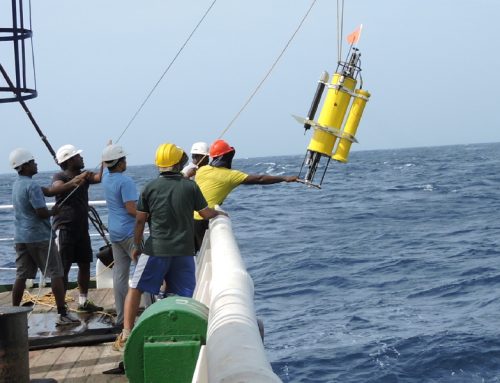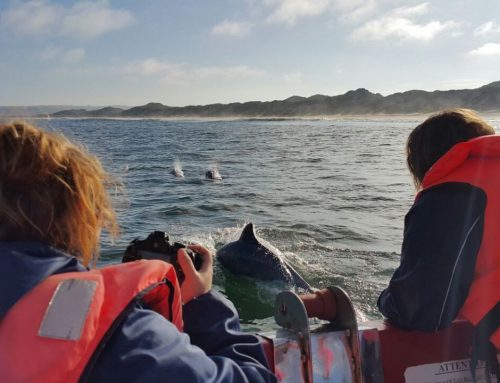 South Africa’s offshore marine ecosystems are the most poorly protected of all South African ecosystems and environments. None of South Africa’s 23 Marine Protected Areas are offshore, not even Prince Edward Island, which is yet to be declared after ten years of planning and motivation. “What this means is that establishing offshore marine protected areas is a national priority,” says marine ecologist Dr Kerry Sink from the South African National Biodiversity Institute (SANBI) in Cape Town whose team completed South Africa’s first comprehensive National Marine and Coastal Biodiversity Assessment this year.
South Africa’s offshore marine ecosystems are the most poorly protected of all South African ecosystems and environments. None of South Africa’s 23 Marine Protected Areas are offshore, not even Prince Edward Island, which is yet to be declared after ten years of planning and motivation. “What this means is that establishing offshore marine protected areas is a national priority,” says marine ecologist Dr Kerry Sink from the South African National Biodiversity Institute (SANBI) in Cape Town whose team completed South Africa’s first comprehensive National Marine and Coastal Biodiversity Assessment this year.
Funded by the WWF Nedbank Green Trust in collaboration with a host of marine and coastal-related departments and institutes, the marine component covers one of the six environments in South Africa – including terrestrial, river, estuarine and wetland, coastal and inshore, and offshore – that have been included in the National Biodiversity Assessment (NBA). For the past year Sink and her colleagues at SANBI have been working on completing the NBA 2011, which was launched on World Biodiversity Day (22 May 2012) at the iSimangaliso Wetland Park in KwaZulu Natal.
“The NBA is a science-based process, the main purpose of which is to provide headline indicators of the ecosystem threat status and ecosystem protection level across all environments. It critically informs what actions need to be taken to effectively manage our environments, and it helps unlock the value of biodiversity and ecosystems in support of the country’s development path,” explains Sink who also co-authored the synthesis report that summarises the outcomes across all environments.
The absence of protection of the marine offshore ecosystems was highlighted as requiring urgent government action and policy intervention.
Towards demonstrating this, Sink and her team mapped 136 coastal and marine habitats for the first time in the National Marine and Coastal Biodiversity Assessment. Of these 136 habitats, 78 are offshore, situated in the pelagic and benthick zones. “Out of 136 coastal and marine habitats, 46% are threatened and 40% are not represented in MPAs. In other words, they have zero protection. Most of these habitats are offshore, in waters deeper than 30 metres,” says Sink. “The positive aspect of this is that we have completed the critical assessments, so we now know where to focus our efforts and exactly where to create additional offshore MPAs.”
Important feeding areas were factored into the planning for focus areas for offshore protection. A key recommendation is an offshore extension of the iSimangaliso Wetland Park.
If the government acts now we can create a far better developed and representative marine protection system, with integrated management between the Departments of the Environment, Fisheries and Tourism.
South Africa has exceptional marine biodiversity with approximately 2000 fish species and at least 10 000 species of invertebrates and plants. Many species, an estimated 33%, are found only in South Africa and our knowledge of the vast majority is hopelessly inadequate.
While many of our marine seafood species are overexploited, Sink is optimistic that if we act immediately they can recover for long-term sustainability and economic benefit. “We need to use the scientific assessment we now have available to us to wisely allocate our marine resources by implementing an ecosystems approach to fisheries. Resource allocations need to be grounded in the realities of resource abundance or the lack of it.”
To achieve this we need to balance fisheries supply and demand, Sink explains: “If we are going to establish more smallscale fisheries, for example, we may need to reduce the allocations to largescale fisheries. Allocating more resources from the same pie simply won’t be sustainable.”
Included in the National Marine and Coastal Biodiversity Assessment is the Reef Atlas, completed in December 2011 and financed by the WWF Green Trust. “The Reef Atlas has 390 mapped reef systems, several of which have been identified for the first time. It includes 1300 photos with corresponding gps co-ordinates, and we will keep adding to it each year as new information becomes available,” says SANBI Marine Projects Manager, Prideel Majiedt, who led the Reef Atlas Project together with SANBI’s Marine Programme Manager, Dr Kerry Sink.
In addition to the offshore environment, another area of concern in the NBA report is the threat to coastal and inshore marine systems up to a depth of 30 metres and within three kilometers from shore. Key drivers of this threat include coastal pollution, coastal development, coastal fisheries and wastewater discharge.
Also of concern are marine invasive species. “We have eight identified marine invasive species in South Africa at present, but there are definitely more and we need a thorough assessment, stringent monitoring and quick action to contain these,” says Sink. Some of the marine invasive species include Mediterranean mussels, barnacles from the northeast Atlantic and the European green crab. The main carriers of these species are shipping, mariculture and petroleum activities. South Africa doesn’t have a ballast water strategy, for example, which is essential to contain the spread of these species.
Where climate change is concerned, while new maps have been produced for terrestrial areas that are important for climate change, Sink says that South Africa is not yet advanced enough to understand the impacts of climate change on our oceans. “We are still in the process of mapping species and habitat types in the ocean, which means we are not at the stage where we can adequately detect changes in them or in our oceans,” explains Sink whose next giant leap in marine conservation is to develop a Fish Atlas for South Africa. To achieve this she hopes to include South Africa’s 800 000 recreational fishers and thousands of divers as citizen scientists who can help record and gps marine species.
“The Reef Atlas successfully collaborated with scuba divers, dive schools and citizen science groups such as the Southern Underwater Research Group (SURG) to map South Africa’s reefs. We want to build on this approach to create a species map for the marine environment,” says Sink.
“At this stage we don’t even know how many fish species we have and we know even less about the invertebrates. Citizen scientists (members of the public contributing to science) can play a great role here. The Reef Atlas and the Southern African Sustainable Seafood Initiative (SASSI) have proved that people want to help and that they can contribute so much to science.”
For more information on the NBA see http://biodiversityadvisor.sanbi.org/




